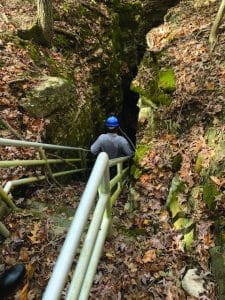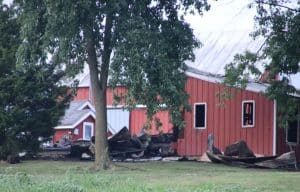Illinois Caverns to reopen this year

Pictured, a man walks down into the caves of Illinois Caverns. Located at 4369 G Road in Waterloo, the attraction is set to open later this year after being closed for more than a decade.
After being closed for more than a decade, one of Monroe County’s two most famous cave systems is set to reopen to the public later this year.
The Illinois Department of Natural Resources confirmed that it plans to reopen Illinois Caverns, located at 4369 G Road south of Burksville, to the public later this summer.
“The prospect of Illinois Caverns reopening to the public is an exciting and important development,” said Clifftop Vice President Bob Weck. “The closure of the cave in 2010 meant the loss of an important educational and recreational resource.”
According to a closure notice on the IDNR’s website, the caves closed indefinitely in early 2010 because of the discovery of White-Nose Syndrome in bats, a new disease that had an unknown origin and killed hundreds of thousands of bats over three years in the northeastern United States.
Data at the time indicated that human activity in caves may have contributed to the spread of the WNS, so the IDNR closed the Illinois Caverns and other caves because they are home to many federally endangered bat species and some large hibernating bat populations.
It has since killed millions of bats in North America, has been confirmed in nearly half of all hibernating species and is considered widespread across the continent, IDNR Deputy Director Rachel Torbert said.
The disease may be inadvertently transmitted by humans on their clothing and gear, but it is not dangerous to humans or contracted by them, Torbert emphasized.
She also said WNS and the white fungus characteristic of it was not often found in Illinois Caverns.
“Compared to many other caves and mines in Illinois testing positive for WNS, the prevalence of this disease in bats hibernating within Illinois Caverns has been relatively low,” Torbert said. “A small number of animals exhibiting the white fungal growth on their muzzles was first documented at Illinois Caverns in 2013. Since then, instances of WNS at Illinois Caverns continue to be very localized. Massive, uncontrolled spread throughout the cave has not occurred. Even though WNS was observed in a small number of bats in Illinois Caverns, the bat population was never significant in this cave and seems to remain relatives the same despite WNS being witnessed in some animals.”
With that low level of infection among the few bats in the caverns, Torbert said part of why the state natural area has remained closed is that its entrance gate needed to be repaired to protect the safety of visitors.
Although there is no cure for WNS, the low prevalence of the illness in Illinois Caverns and ability to make needed repairs has made the reopening possible – as long as spring weather does not delay site repairs and updates.
Torbert said that work includes replacing the exterior doors, updating the education building, bringing in portable toilets until a permanent restroom can be devised and creating and printing brochures.
Additionally, she said staff has maintained the site while it has been closed and the state is in the process of hiring and training new seasonal staff.
When the caverns reopen, although WNS is not prevalent at the Illinois Caverns, Torbert said it will be important to clean and disinfect your clothes if you go from one cave to another or visit places known to have bats.
Decontamination guidelines include removing sediment from clothes and gear, cleaning any exposed skin with soap and water, disinfecting gear like flashlights and helmets and washing all clothing at home.
That will help to prevent the spread of WNS among bats.
Torbert said the IDNR is looking forward to children being able to learn about caves through Illinois Caverns, which the IDNR describes as containing “extensive array of spectacular cave formations, including stalactites, stalagmites, rimstones dams, flowsone and soda straws” and “a delicately balanced and fragile community of animals”
“It presents educational opportunities for school-aged children as well as adults looking for something other than one of our existing outdoor program offerings,” Torbert said of the caverns.
Weck agreed with that sentiment.
“Monroe County has the most intense karst topography in the state, with thousands of sinkholes and hundreds of known caves. Yet, there are currently no caves on public land that are open to visitation,” he said. “When it comes to fostering an understanding of the inner workings of cave ecosystems, there is no substitute for the experience of actually visiting a cave.”
In addition to the Illinois Caverns, which have been called the second-largest caves in the state, Monroe County also boasts the Fogelpole Cave System that Clifftop has said is the largest in the state and the IDNR describes as “one of the largest and least disturbed” in the state.
That cave, located at Clifftop’s Paul Wightman Subterranean Nature Preserve in Fults, is not open to the public.






